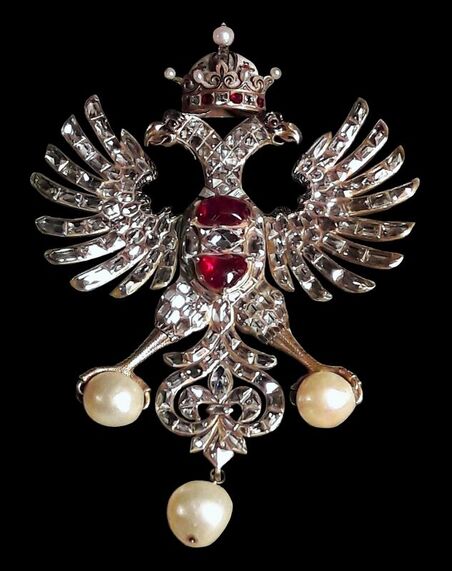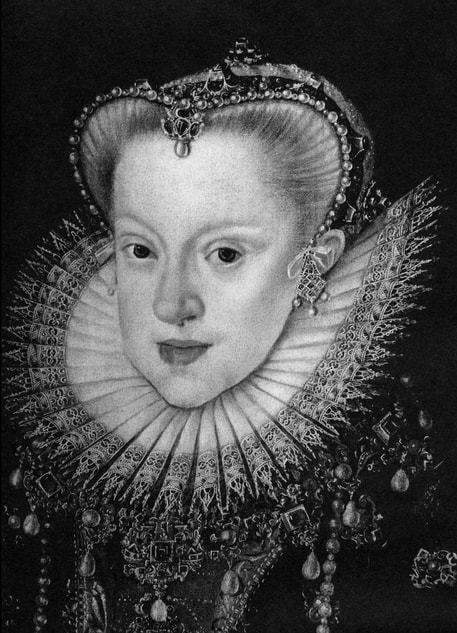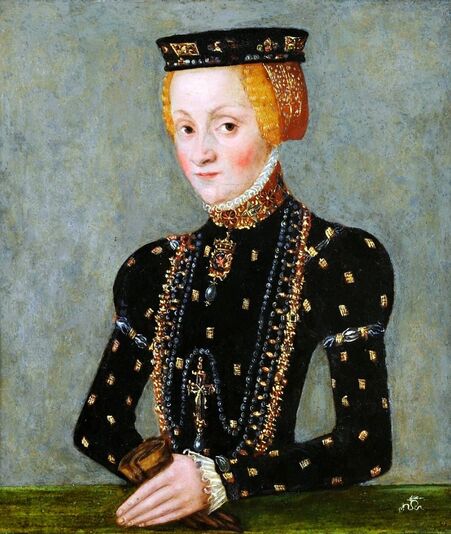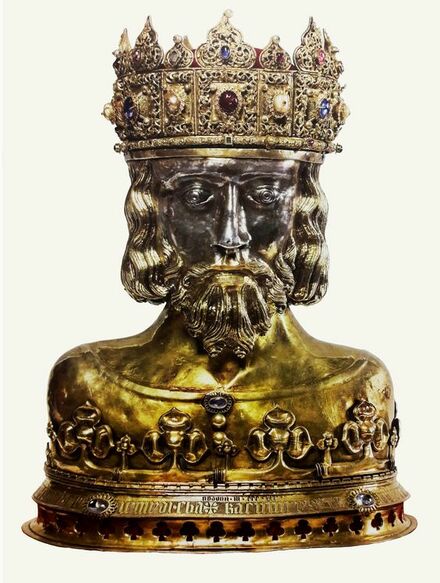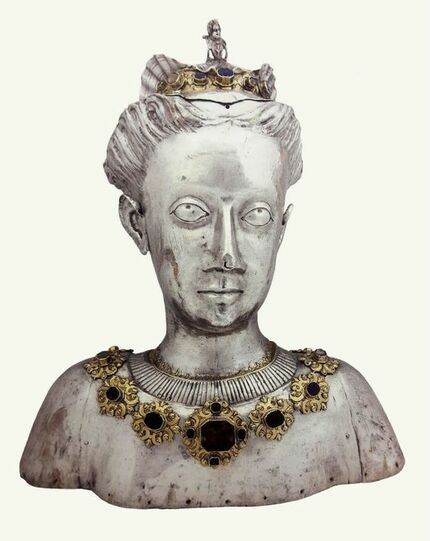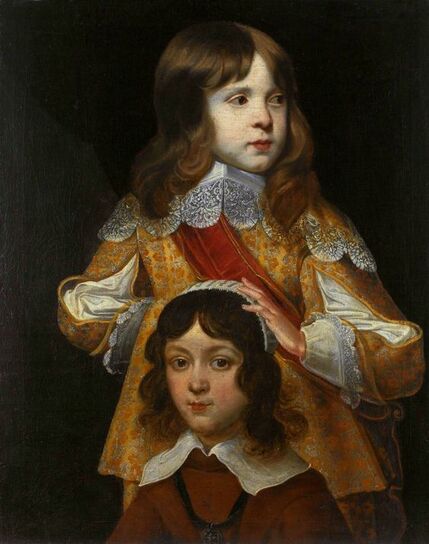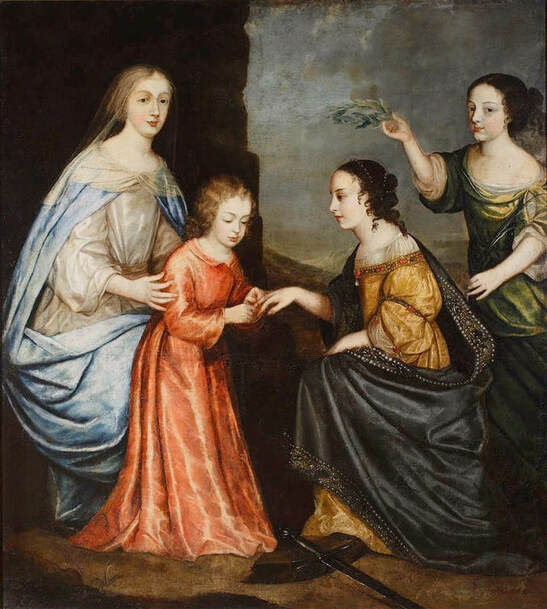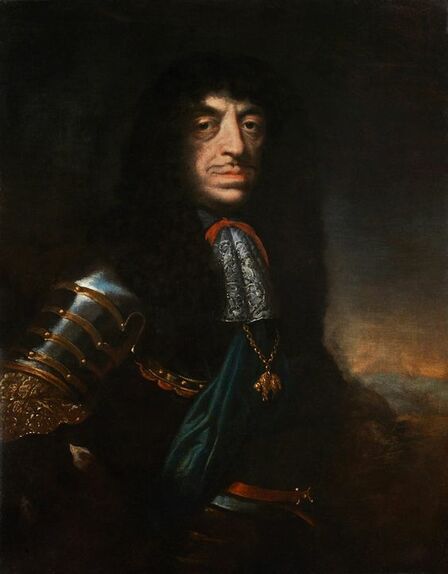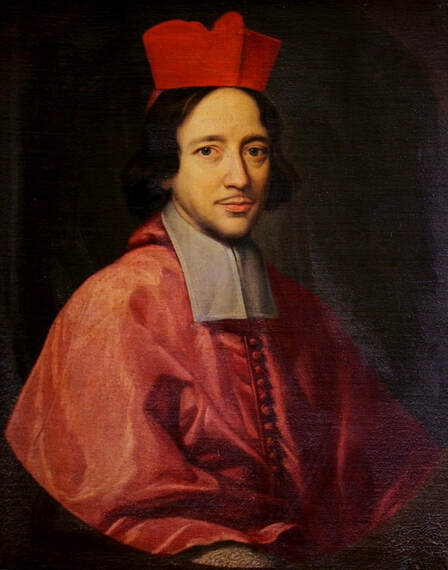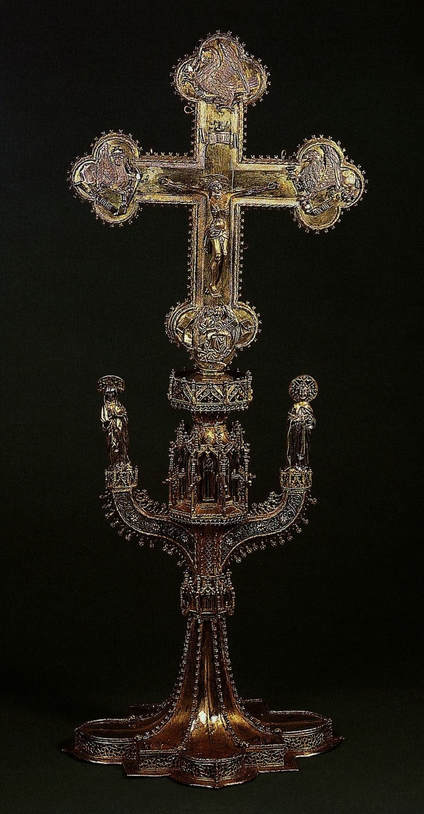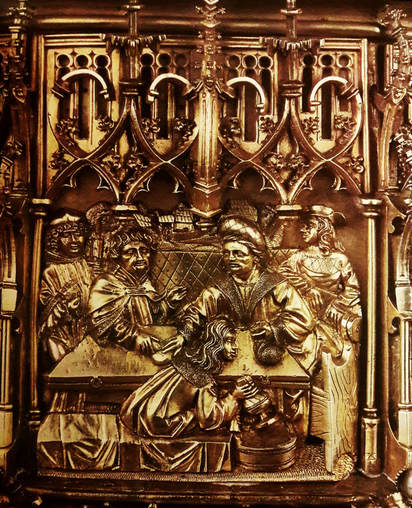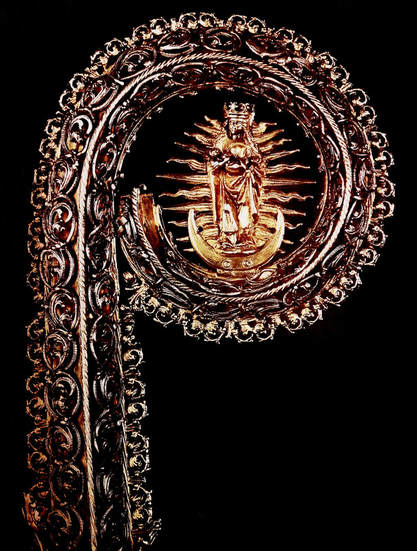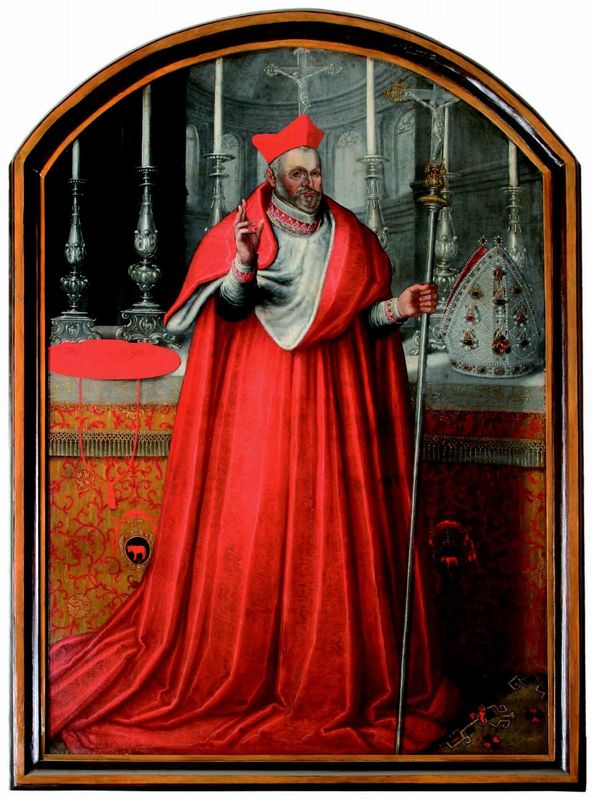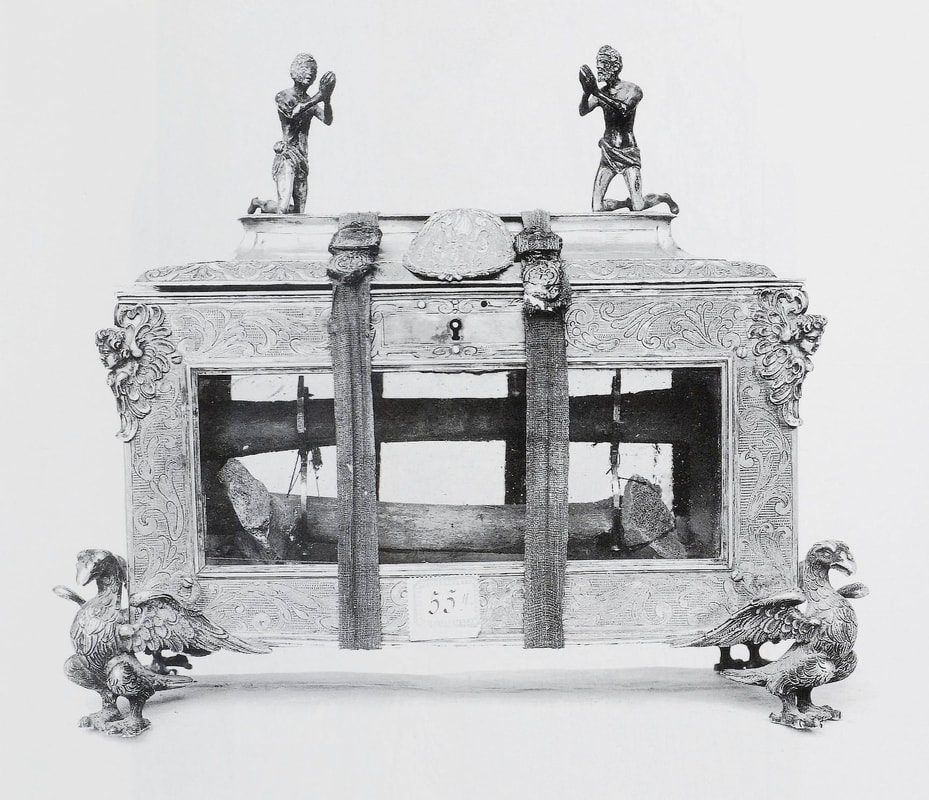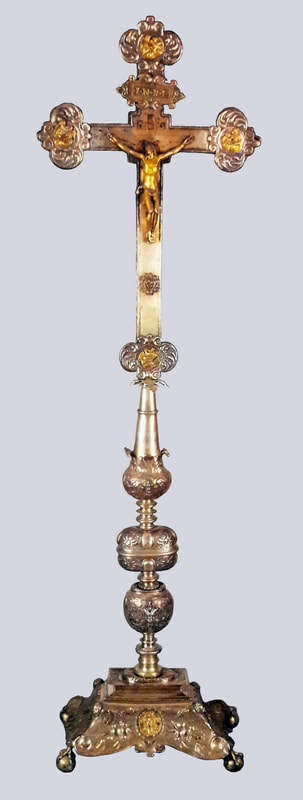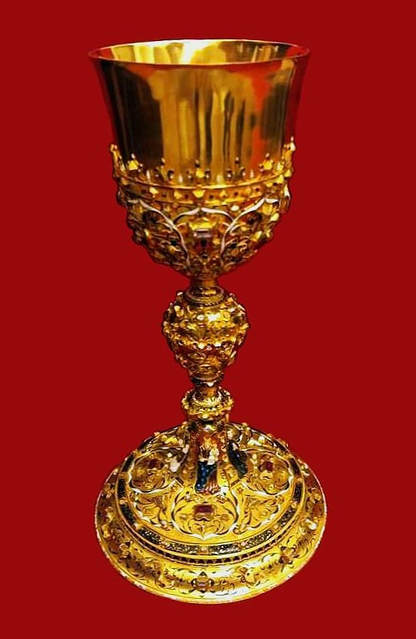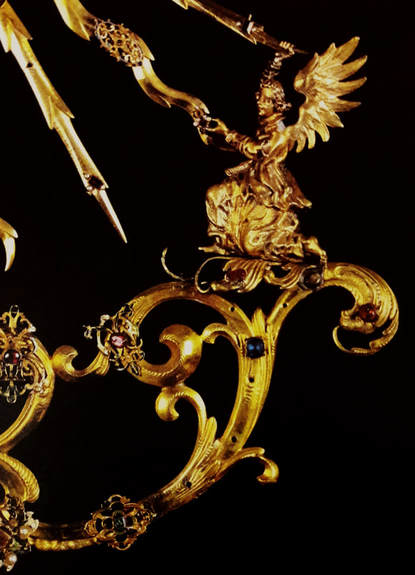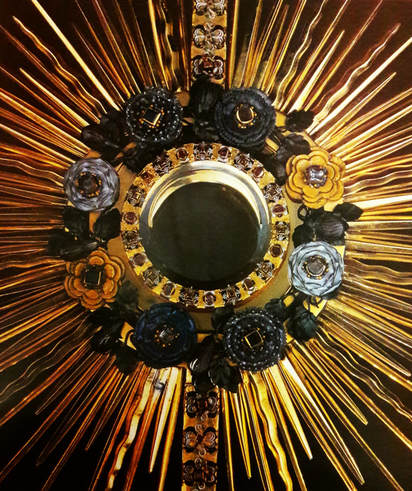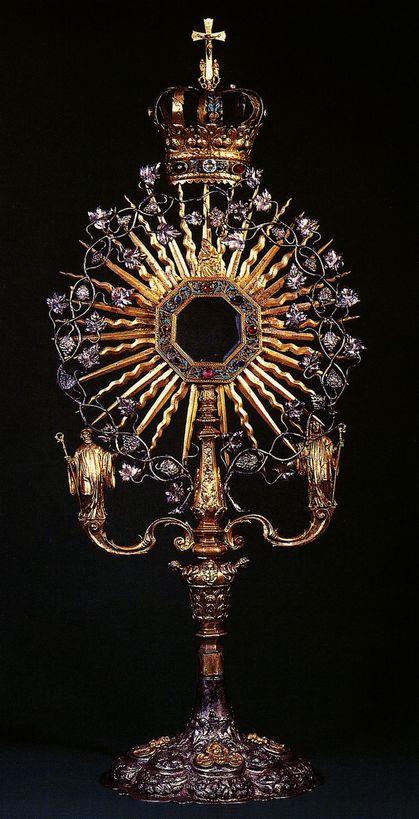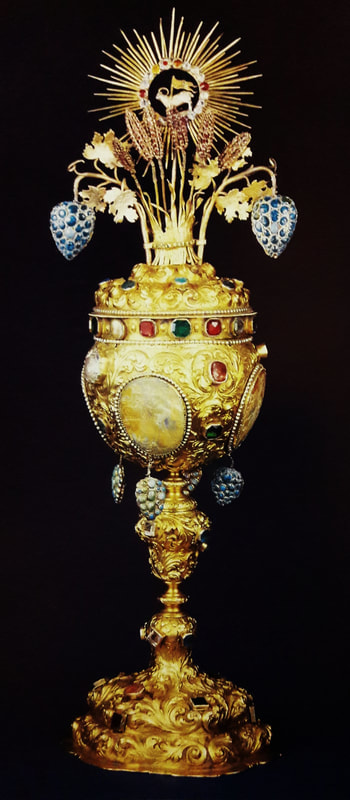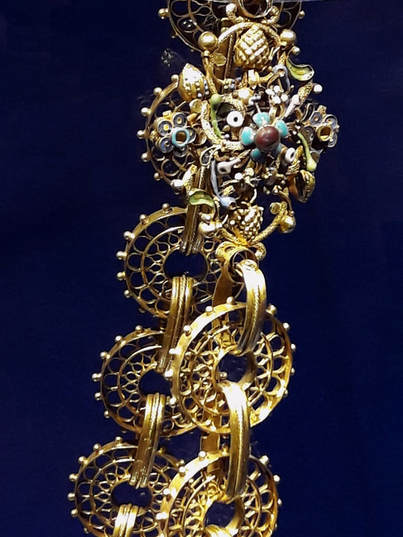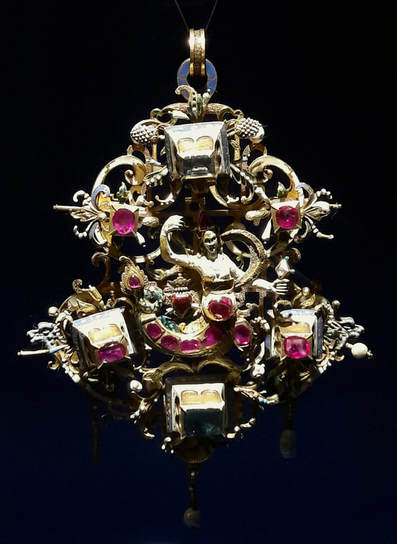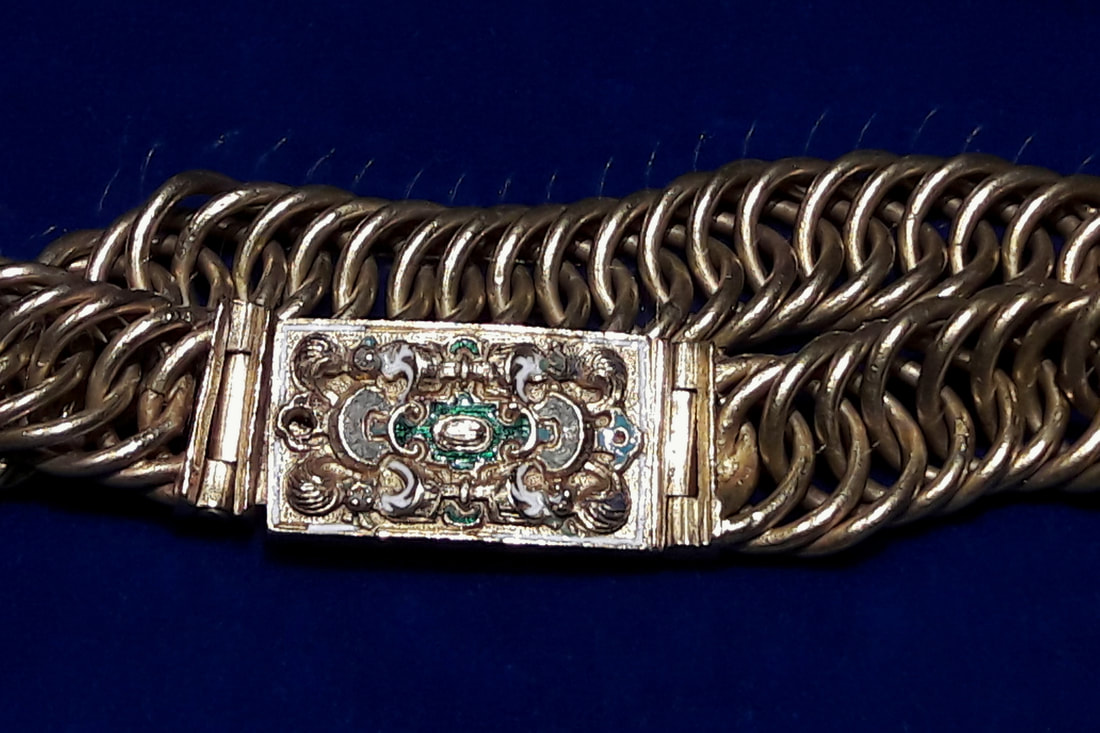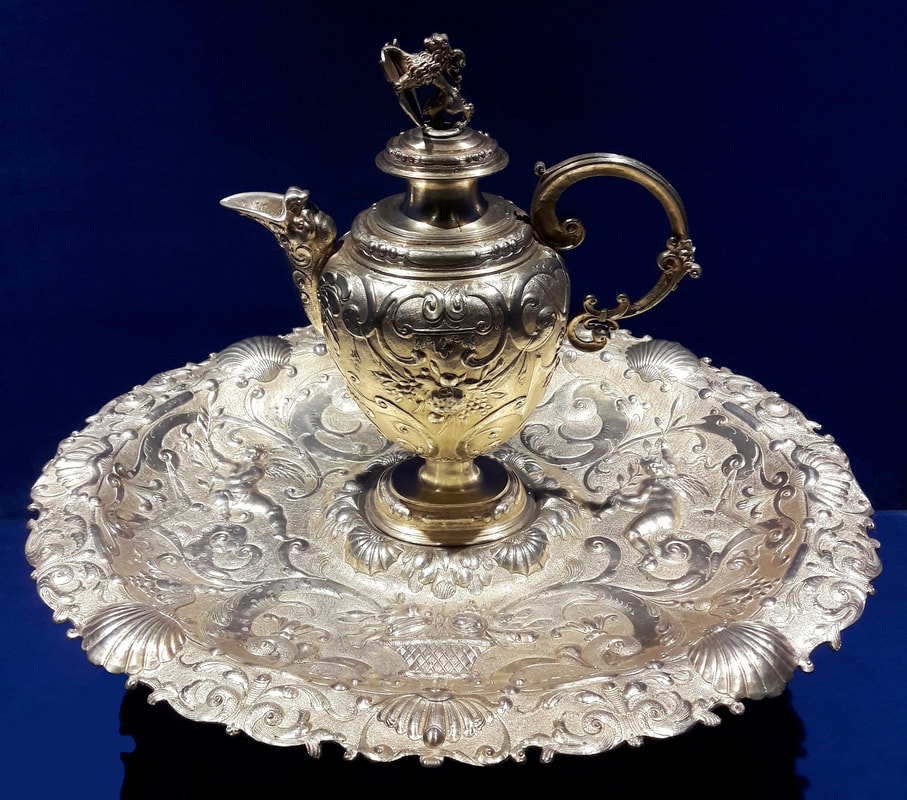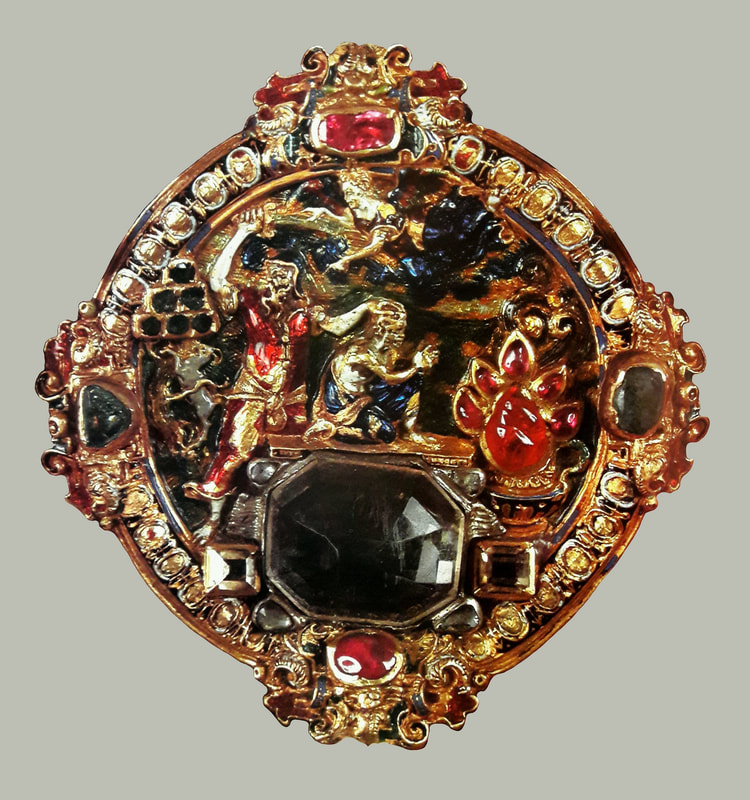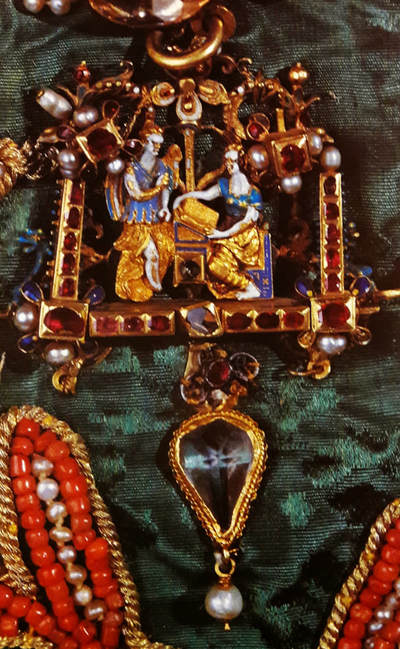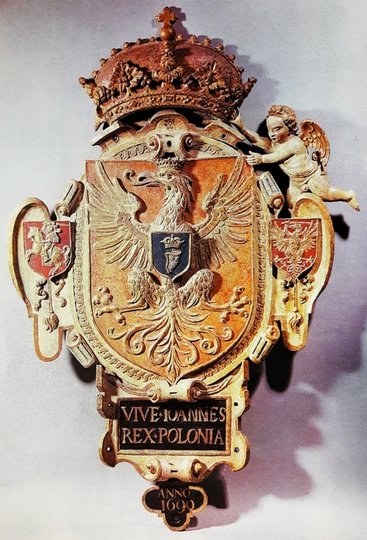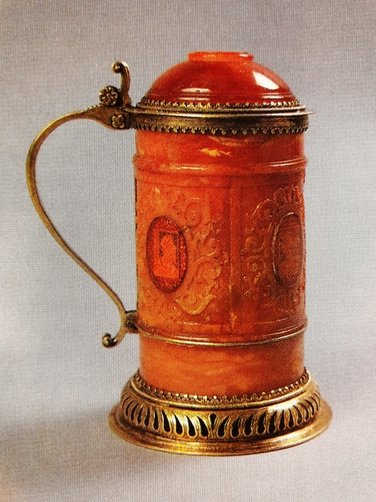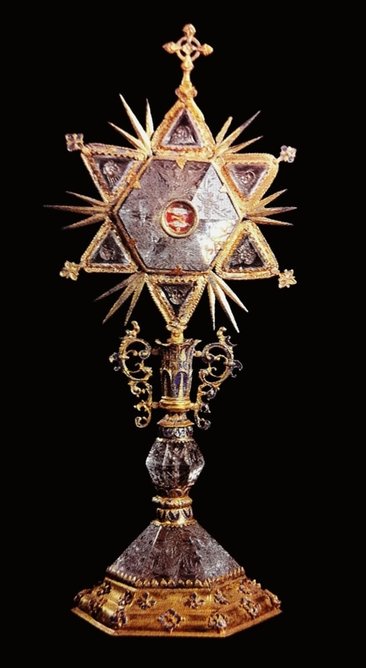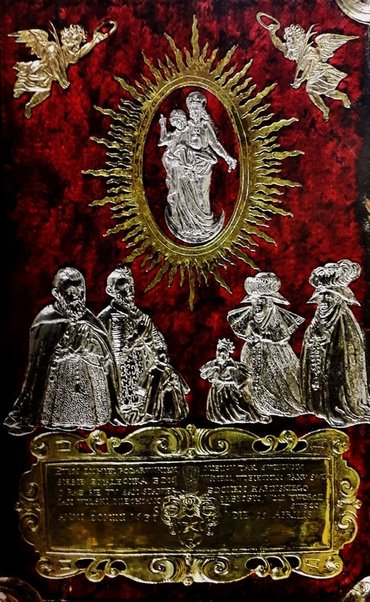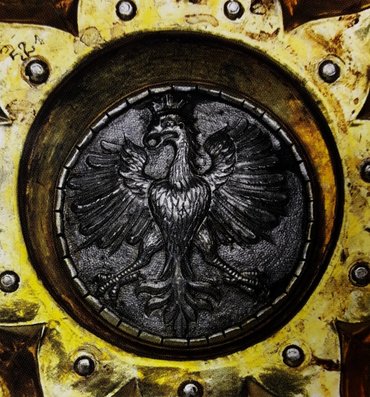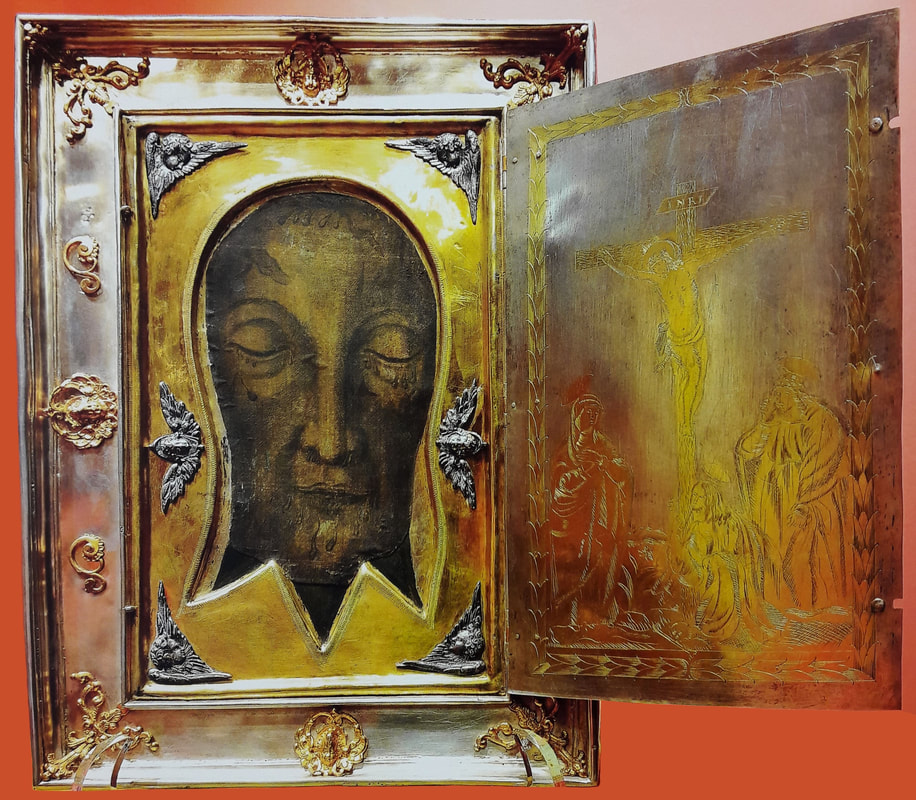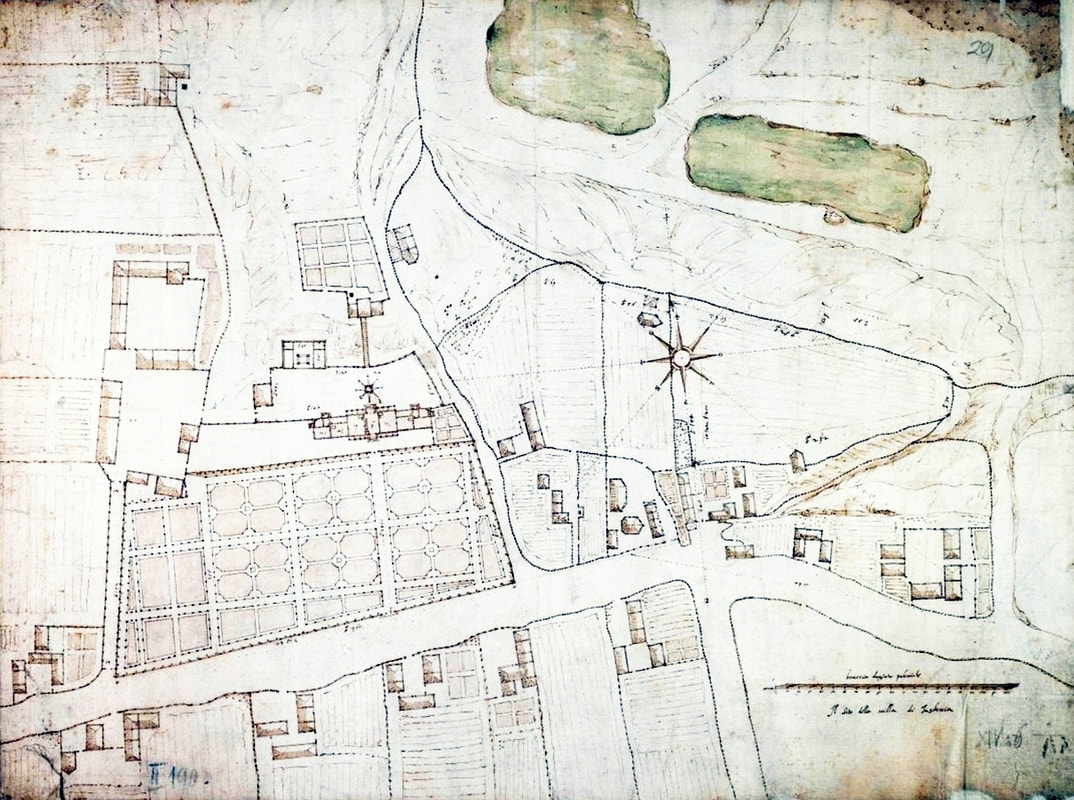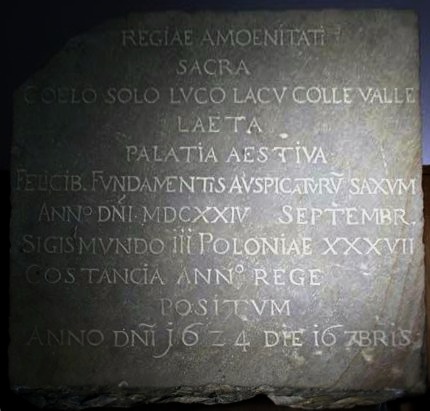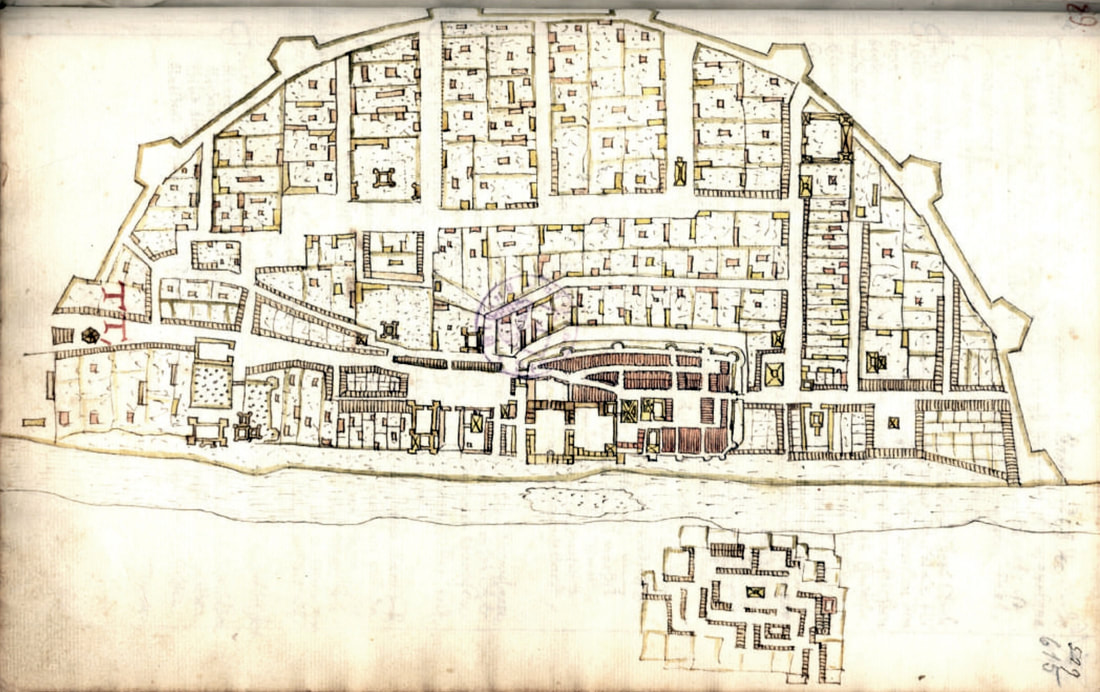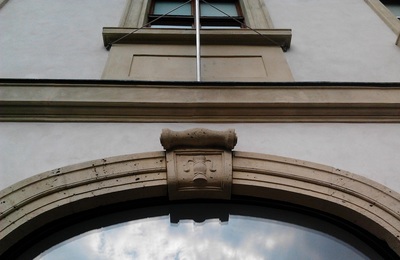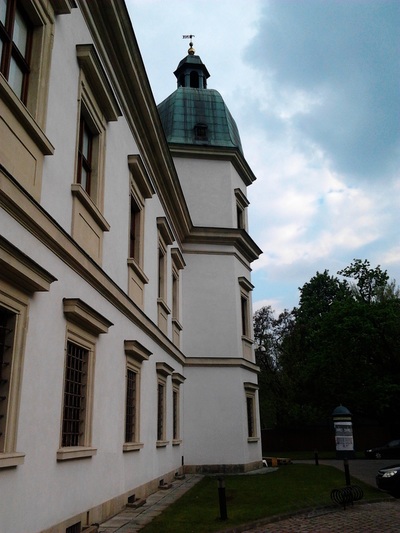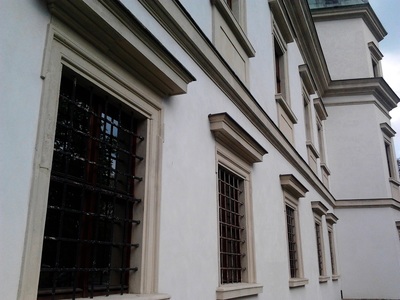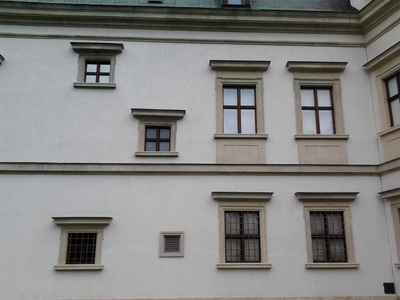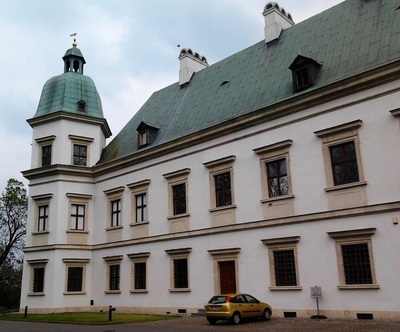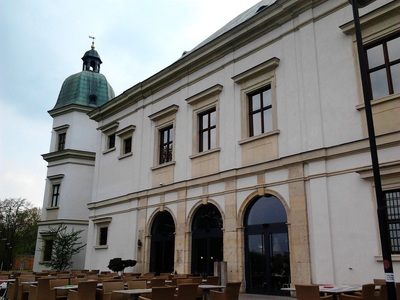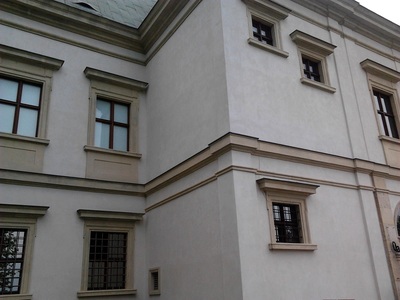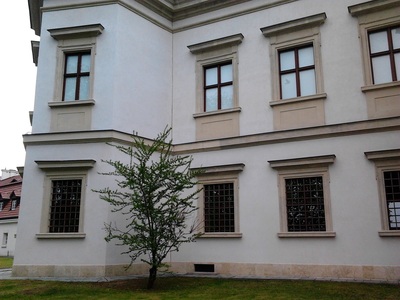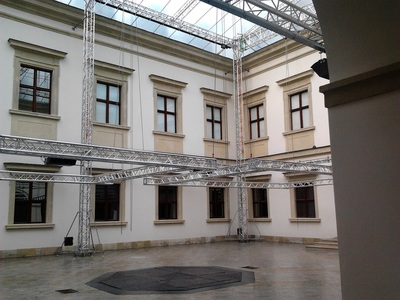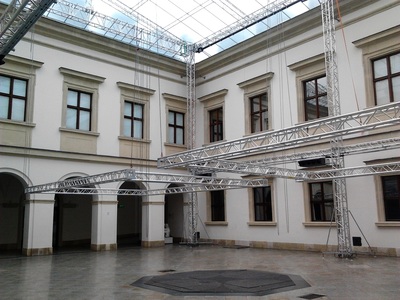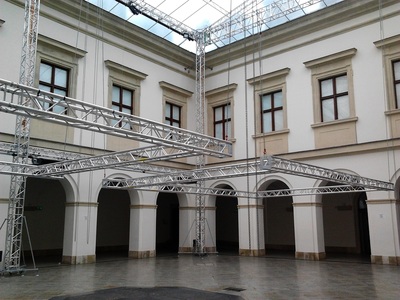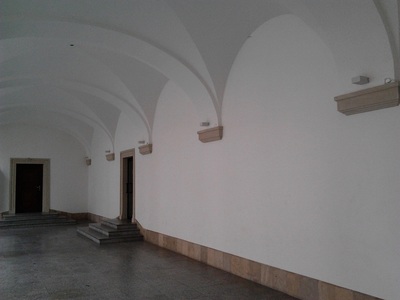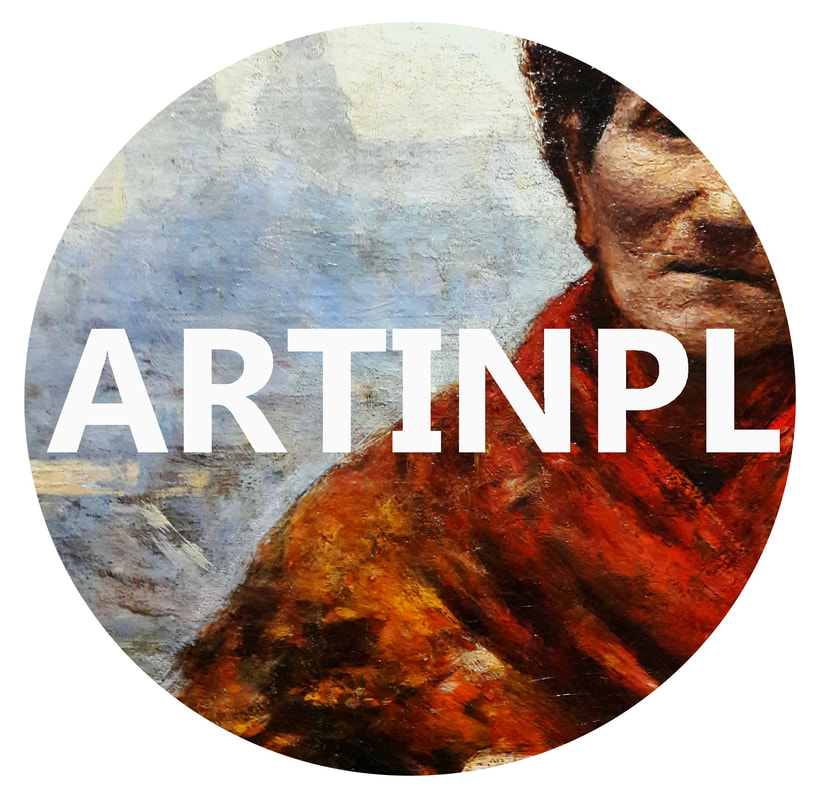|
At the beginning of January 1606 arrived to Kraków Jan Buczynski, secretary of tsar False Dmitry I of Russia, with the mission to acquire jewels for his patron. Several merchants from Kraków and Lviv, as well as jewellers Mikołaj Siedmiradzki and Giovanni Ambrogio Cellari from Milan, encouraged by the prospect of a large gain, embarked on a journey to Moscow.
Princess Anna Vasa (1568-1625) who owned a collection of jewels valued by some at 200,000 thalers, decided also to secretly sell to the tsar a part of it. Stanisław Niemojewski (ca. 1560-1620) of Rola coat of arms, Crown Deputy Master of the Pantry, was appointed to deliver jewels worth of 70,000 zlotys "wrapped in colourful silk" in an iron casked "painted in green". False Dmitry was killed on May 17th, 1606 and it was not as early as 1609 when the collection was returned by the new tsar Vasiliy Ivanovich Shuisky. Among jewels returned was "eagle with two diamond heads with rubies", most probably from princess' collection or pawned with Niemojewski from the State Treasury before 1599. Such hereldic jewels, either Imperial-Austrian or Polish, were undobtedly in possesion of different queens and princesses of Poland since at least 1543, when Elizabeth of Austria (1526-1545) was presented with a "diamond eagle with rubies" by emperor Charles V on the occasion of her marriage with king Sigismund II Augustus of Poland. Inventory of the jewels of Polish princess Anna Catherine Constance Vasa, daughter of Sigismund III and Constance of Austria, include four pendans and two pair of earrings with eagles, unfailingly three Imperial-Austrian and two Polish: "a pendant with a white, enamelled Eagle, at which seven diamonds, three round pearls and one big hanging ", valued at 120 thalers and "a diamond eagle with a sharply cut diamond in the center, more diamonds around and three hanging pearls". Anna Vasa, in half a princess of Poland, as a daughter of Catherine Jagiellon and sister of king Sigismund III, was as such entitled to use this emblem. After Sigismund's defeat at the Battle of Stångebro in 1598, she left Sweden to live with him in Poland where she spent the rest of her life. The miniature portrait of a lady with eagle pendant from Harrach collection in Vienna (Harrach Palace at Freyung Street) previously identified as effigy of Anna of Austria (1573-1598), first wife of king Sigismund III, basing on strong resemblance to portrait of Catherine Jagiellon, if at all connected with Poland, should be rather identified as a portrait of king’s sister Anna Vasa, and not as his wife. The lack of protruding lip, notorious "Habsburg jaw" known from Anna of Austria’s preserved portraits and costume of the sitter, according to Northern fashion and not Spanish of the Imperial court, confirms this hypothesis. Eagle was a symbol of supreme imperial power, epitomized magnanimity, the Ascension to heaven and regeneration by baptism and was used in jewellery all across Europe at that time. If the pendant is a heraldic symbol than the portrait should be dated to about 1592, when Sigismund was prepared to abandon the Polish throne for Ernest of Austria, who was about to marry princess Anna Vasa (this would also explain how the miniature found its way to Austria) or to 1598, when the princess needed to legitimize herself in her new homeland.
Diamond double-headed eagle of the House of Austria by Anonymous from Milan or Vienna, mid-16th century, Treasury of the Munich Residence. Most probably from dowry of princess Anna Catherine Constance Vasa.
Detail of a portrait of queen Anna of Austria (1573-1598) by Martin Kober, 1595, Bavarian State Painting Collections.
Miniature of princess Catherine Jagiellon (1526-1583) by workshop of Lucas Cranach the Younger, ca. 1553, Czartoryski Museum.
Miniature of a lady with eagle pendant, most probably princess Anna Vasa (1568-1625) by Anonymous, 1590s, Harrach collection in Rohrau Castle (?). Identification by Marcin Latka.
See the work in Polish-Lithuanian Treasures.
When in 1598 died queen Anna of Austria, first wife of Sigismund III Vasa, a young a chamberlain of the queen's court and governess to the king's children, Urszula Meyerin, took her position not only in the king's bed but also at the court and in country's politics. This seven-year period between first and second marriage of the king, marked by increasing role of his mistress and "a minister in a skirt" as she was called, is most probably reflected in the reliquary of Saint Ursula in the Diocesan Museum in Płock.
Before 1601 king Sigismund III ordered a goldsmith of Płock, Stanisław Zemelka, to adorn a reliquary bust of his patron Saint Sigismund in the Płock Cathedral with a gold crown from his treasury. Around the same year the king's close ally and protégé, Wojciech Baranowski, Bishop of Płock, commissioned in the workshop of royal goldsmith a silver bust for relics of Saint Ursula from the Płock Cathedral, which was to be transferred to newly established Jesuit Collegium in Pułtusk. Urszula Meyerin, a supporter of Jesuits who corresponded with the Pope and used her influence on the king to appoint her favourites to state positions, deserved the honor to give her effigy to the virgin martyr Ursula, which would be another reason for king's gratitude towards Baranowski. It is also possible that the king, himself a talented goldsmith, participated in execution of this commission, hence the lack of signature on the work.
Silver reliquary of Saint Sigismund with gold Płock Diadem by Anonymous from Kraków (reliquary) and Anonymous from Hungary or Germany (diadem), second quarter of 13th century and 1370, Diocesan Museum in Płock.
Silver reliquary of Saint Ursula in the form of a bust by Stanisław Ditrich, ca. 1600, Diocesan Museum in Płock.
In 1637, when 42-years-old king Ladislaus IV Vasa decided to marry finally, the situation at the court of his mistress Jadwiga Łuszkowska become difficult. It was probably thanks to efforts of king's wife, imperial daughter, Cecilia Renata of Austria, that Jadwiga was married to Jan Wypyski, starost of Merkinė in Lithuania and left the court in Warsaw.
Portrait of Prince Sigismund Casimir Vasa with a page (possibly illegitimate son of Łuszkowska and Ladislaus IV - Ladislaus Constantine Vasa, future Count of Wasenau) by circle of Peter Danckerts de Rij, ca. 1647, National Gallery in Prague.
Around 1659, when the great war, known is Polish history as the Deluge, was coming to the end, it become obvious to everybody that 48-years-old queen Marie Louise Gonzaga would not give a birth to a child, everybody at the court in Warsaw were thinking on possible heir to the throne. Powerful queen gave birth to a son in 1652, but the child died after a month. The old king John Casimir Vasa, former cardinal, who finding himself unsuited to ecclesiastical life, stood in elections for the Polish throne after death of his brother and married his sister-in-law, had however at least one illegitimate child, a daughter Marie Catherine, and possibly a son.
The painting offered by queen Marie Louise to the Church of the Holy Cross in Warsaw in about 1667 and created by court artist around 1659, depicts the eldest son of king’s mistress Katarzyna Franciszka (Catherine Frances) Denhoffowa. 10 years old John Casimir Denhoff as young Jesus, held by childless queen Marie Louise depicted as Virgin Mary, is offering a ring to his mother in the costume of Saint Catherine. Katarzyna Franciszka Denhoffowa nee von Bessen (or von Bees) from Olesno in Silesia and her younger sister Anna Zuzanna were maids of honor of queen Cecilia Renata and stayed at the court after queen’s death. Denhoffowa become a trusted maid of a new queen and her second husband John Casimir. In 1648, she married a courtier of John Casimir, Teodor Denhoff, and a year later on June 6, 1649 she gave birth to John Casimir Denhoff, future cardinal. Godparents of the young Denhoff were none other than king and queen herself. In 1666 at the age of 17 he was made abbot of Mogiła Abbey and between 1670 and 1674 he studied canon law in Paris under protection of John Casimir Vasa.
Mystical marriage of Saint Catherine, possibly by Jan Tricius, ca. 1659, National Museum in Warsaw.
Portrait of king John II Casimir Vasa by Daniel Schultz, 1659, Royal Baths Museum in Warsaw.
Portrait of cardinal John Casimir Denhoff by circle of Giovanni Maria Morandi, after 1687, Private collection.
See more pictures of the Polish Vasas on Pinterest - Artinpl and Artinplhub
Main religious centers of Poland were also main centers for religious craftemanship in the country. Kraków with its status of coronation city and largest city of southern Poland had an adantage over other locations with the largest number of goldsmiths. A diploma issued in 1478 by Jan Rzeszowski, Bishop of Kraków, Jakub Dembiński, castellan and starost of Kraków, Zejfreth, mayor of Kraków, Karniowski and Jan Theschnar, Kraków's concillors to Jan Gloger, son of Mikołaj Gloger, aurifaber (goldsmith) of Kraków, recognizes Jan as a man of good fame and worthy of admission to the guild of goldsmiths. The document confirms that church had a profound influence on development of this craftsmanship in the country.
Reliquary cross of Andrzej Nosek of Rawicz coat of arms, Abbot of the Tyniec Abbey by Anonymous from Kraków, ca. 1480, Cathedral Treasury in Tarnów.
Fragment of gold reliquary for the head of Saint Stanislaus with selling of a village by Marcin Marciniec, 1504, Cathedral Museum at Wawel Hill in Kraków.
Silver crosier of Bishop Andrzej Krzycki by Anonymous from Kraków, 1527-1535, Płock Cathedral.
Portrait of Primate Bernard Maciejowski (1548-1608) by Anonymous from Kraków, ca. 1606, Franciscan Monastery in Kraków. The Primate was depicted holding silver legate's cross against silver altar set commissioned by him before 1601 in Italy and with a 15th century jewelled mitre of cardinal Frederick Jagiellon.
Reliquary of Saint Stanislaus founded by Bishop Marcin Szyszkowski by Anonymous from Poland, ca. 1616-1621, Basilica of Saint Francis of Assisi.
Silver altar cross offered by Primate Wacław Leszczyński to the Gniezno Cathedral by Anonymous from Poland, first quarter of the 17th century, Archdiocesan Museum in Gniezno.
Gold chalice founded by Anna Alojza Chodkiewicz by Anonymous from Poland, ca. 1633, Treasury of the Lublin Archcathedral.
Fragment of a monstrance adorned with jewels from private donations by Anonymous from Lublin, ca. 1650, Dominican Monastery in Lublin.
Fragment of monstrance adorned with enamel by Anonymous from Poland, 1670s, Treasury of the Jasna Góra Monastery.
Monstrance with St. Benedict and St. Scholastica from the Tyniec Abbey by Anonymous from Lesser Poland, 1679, Cathedral Treasury in Tarnów.
Ciborium adorned with mother of pearl founded by guardian Stefan Opatkowski by Anonymous from Kraków, 1700, Franciscan Monastery in Kraków.
The invasion of the Polish-Lithuanian Commonwealth by neighbouring countries in the year of 1655 ended almost a century period of prosperity since the establishment of the noble republic in 1569. This war, one of the worst in country's history, and known as the Deluge (1655-1660), resulted in the loss of approximately 25% of the population in four core provinces, destruction of 188 cities and towns, 81 castles, and 136 churches. It had a profound impact on all aspects of life and future generations as well as on country's culture. Invasion and occupation by Lutherans from north and west (Sweden and Brandenburg), Calvinists from the south (Transylvania) and Orthodox from east and south (Russia, Wallachia and Moldavia) also significantly strengthened Catholics in previously multi-religious nation. The invaders were renowned for looting even marble flooring and church vestments. In 1658 Swedish troops of commander Pleitner murdered in the church in Skrwilno the local vicar, Father Walerian Cząpski for refusing to declare where he hidden "the treasure of the church".
In those circumstances, between 1655 and 1660, Zofia Magdalena Loka of Rogala coat of arms, owner of Okalewo estate and widow of Stanisław Piwo of Prawdzic coat of arms, deputy cup-bearer of Płock, hidden in the remains of the 11th century settlement in Skrwilno, her most valuable belongings. Discovered in 1961 in a shallow, approx. 50-cm excavation, were gold objects of more than 2 kg weigh, and silver objects of about 5 kg weigh. The treasure consist of the most exquist works of art including gold jewellery from the first half of the 17th century, like pendant with the figure of Fortune set with precious stones and coated with blue, white and green enamel, 6 chains including a chain set with precious stones made up of circular open work links and eight rosettes set with rubies and turquoises, 4 bracelets, two of them with clasps laid over with green, blue, or white enamel and the third coated with black enamel bearing the letters I.H.S. engraved amid the acanthus leaf motif, 16 żupan buttons of Stanisław Piwo, 5 gold and set with rubies, 5 with rock crystal, and 6 made of gilded silver. There is also a silver belt with imitation of encrusting, a silver filigree chain, a fragment of filigree gold chain with enamelled elements, 4 rings and 51 pearls. Silver tableware constitute the other part of the treasure. It includes silver lavabo set with Rogala coat of arms created by Balthasar Grill in Augsburg and commissioned by Jan Loka, starost of Borzechowo, father of Zofia, a pair of scissors for trimming candle wicks with Prawdzic coat of arms, two silver candlesticks made in Toruń and Brodnica, 12 silver spoons by Hans Nickel, William de Lassensy, Reinhold Sager and Hans Martelius, finest Toruń silversmiths of the time, and a tankard. Stanisław Piwo died on January 17, 1649 at the age of 53, hence before the invasion, and was buried in the Benedictine nuns Church in Sierpc, where his wife founded him a tomb monument in marble and alabaster depicting him kneeling before the crucified Christ. The tomb was most probably destroyed in 1655, when a Swedish troop looted the Benedictine Monsatery or in 1794 during the fire of the church. Zofia was 10 years younger then her husband and they were married for 26 years. Both Zofia nad Stanisław wer benefactors of many local churches - in 1644 Stanisław offered to the church in Sierpc a gold cloth chasuble and his wife in 1649 offered a silver plaque. In 1650, a year after death of her husband she offered a veil emboidered with gold thread for the image of Our Lady of Sierpc. She lived for few years in her large wooden manor in Okalewo and during the Deluge, she probably left for Gostynin. Nothing is known about her later years.
Gold chain set with precious stones of Zofia Magdalena Loka by Anonymous from Germany or Poland, ca. 1600, District Museum in Toruń.
Pendant with the figure of Fortune of Zofia Magdalena Loka by Anonymous from Transylvania or Poland, turn of the 16th and 17th century, District Museum in Toruń.
Bracelet with a stylized cartouche of Zofia Magdalena Loka by Anonymous from Poland, first quarter of the 17th century, District Museum in Toruń.
Silver lavabo set of Jan Loka, starost of Borzechowo by Balthasar Grill, 1615-1617, District Museum in Toruń.
The inventory was prepared by a special commision appointed by King John III Sobieski and formed in 1681 basing on the Parliament decission from the same year.
(Extract) Casket IV. 14. Diamond pendant with monogram S.A. [of Sigismund Augustus], under a crown set with rubies, with three additional rubies and a large pear-shaped pearl. 17. Clasp with diamond Saint Michael, set with a large ruby [?], an emerald, 6 smaller rubies, 3 pearls. 18. Diamond cross, 6 rubies, 3 emeralds. 19. Cross with 10 diamonds, 3 pearls. 21. Medallion with Venus and Mars with 2 sharp diamonds, 12 smaller diamonds, 10 rubies. 28. Pendant with letter A [of Queen Anna Jagiellon?] made from 4 rubies, round pearl. 36. Whistle in the form of a owl, 2 rubies, 2 diamonds, 2 diamond roses, 5 pearls. 37. Medallion with Leda and the swan, 8 diamonds, 3 rubies, emerald. 39. Cameo with bust of Charles V on yellow stone. 41. Medallion with the Judgement of Paris, diamonds, rubies. 50. Medallion with the Gigantomachy with a ruby in the center, 6 other rubies, 7 diamonds. 52. Clasp with King David, 2 rubies, smaller diamond, 25 diamonds, rubies, emeralds. 53. Large clasp with diamond Saint George, pearl dragon, 6 pearls, 24 other stones. 55. Gold lion, 6 rubies, 4 diamonds, emerald. Casket V. 2. Medallion with god Vulcan, 13 diamonds, small ruby, emerald. 4. Medallion with Gaius Mucius Scaevola, 5 diamonds, 4 rubies. 5. Clasp with diamond Saint George or Saint Michael with different tablets and diamond lilies. 7. Gold effigy of Charles V on stone. 9. Clasp with diamond Saint George without a horse. 11. Pendant with diamond Christogram IHS, a ruby at the top and a tablet with diamonds, 2 pearls. 13. Clasp with diamond King David, 6 emeralds, 18 rubies, 4 diamonds. 14. Gold dragon pipe with two large diamonds, smaller diamonds, rubies, emeralds, turquoises, 2 pearls. 15. Large clasp with diamond Saint Michael, 3 Indian pearls. 24. Diamond Saint George with emeralds and diamonds, 3 stones missing. 31. Whistle in the form of a Melusine with diamonds and rubies, 1 stone missing, 2 pearls. 33. Medallion with Mars and Venus, 3 rubies, 3 diamonds. 34. Medallion with Judgement of Solomon, emerald rows, 11 rubies, 8 emeralds. 35. Medallion with Deborah and Sisera, 6 diamonds, 4 rubies. 37. Medallion with Marcus Curtius, 3 diamonds, 2 rubies. 38. Medallion with Orpheus, 5 stones. Casket VI. 3. Agate medallion with a Roman face, diamond frame, 3 rubies. 4. Clasp with diamond Saint George, 3 rubies, 3 emeralds, pearls. 5. Medallion with Venus with a mirror, 7 diamonds, small ruby and a small pearl. 7. Pendant with a folded diamond rose, two ruby figures, 3 emeralds, large pearl, 43 tablets of diamonds. Casket VII. 7. Gold fan handle with 5 diamonds, 4 emeralds, 2 turquoises, 11 pearls. 8. Another fan handle, 12 diamonds, 8 rubies, 1 emerald, 16 pearls. Casket X. 3. Large pendant with elongated diamond of 22 1/4 carates, small pearl 12. 14. Largest diamond with a pearl of 27,5 carates weight, valued at 20.000 aureos, pearl 2.500 aureos. Summary of the Jewel Commission presented to the Lord Treasurer of the Crown, Year 1682 Value of all jewels of the Commonwealth in red zlotys ... 101.670
Gold medallion with Sacrifice of Isaac by Anonymous from Poland, turn of the 16th and 17th century, Treasury of the Jasna Góra Monastery.
Gold pendant with Annunciation to Mary by Anonymous from Poland, first quarter of the 17th century, Treasury of the Norbertines Convent in Kraków.
Main centers of craftsmanship in the Polish-Lithuanian Commonwealth (PLC) in the late 16th and at the beginning of the 17th century, a period dominated by late Renaissance forms in arts, were large cities like Gdańsk, Poznań, Vilnius, Lviv and Kraków. Although now perceived as former German territory, Königsberg, known in Polish as Królewiec, was at that time the capital of Duchy of Prussia, a fief of the Crown of Poland, hence part of the Commonwealth and one of the country's important production and trade centers. Amber crafts developed therein, can be therefore considered as integral part of the PLC's production. Mannerist forms in applied arts prevailed till mid-17th century.
Carouche with coat of arms of the Polish-Lithuanian Commonwealth by Anonymous from Gdańsk, 1612, Artus Court in Gdańsk. Modified in 1690 to honour John III Sobieski.
Amber tankard in silver frame by Anonymous from Königsberg, ca. 1610, Czartoryski Museum.
Rock crystal reliquary in silver frame by Anonymous from Kraków, beginning of the 17th century, Mogiła Abbey.
Silver votive plaque with velvet background of Jan Wolski by Anonymous from Poland, 1631, Treasury of the Jasna Góra Monastery.
Polish Eagle, fragment of silver goblet with Saint Catherine by Anonymous from Kraków, first quarter of the 17th century, Kremlin Museum.
Vera icon of Constance of Austria in a silver-gilt frame founded by Primate Jan Wężyk by Anonymous from Poland, 1630s, Diocesan Museum in Łowicz.
The first wooden manor on the site was constructed for Dukes of Masovia in the 15th century. It then belonged, from 1516, to Anna Radziwill, Regent Duchess of Mazovia and to Queen Bona Sforza after 1546 for whom an Italian-style Renaissance garden was created. The new lavish wooden manor in mannerist style was built in 1570s for Anna Jagiellon. It was here that the premiere of blank-verse tragedy "The Dismissal of the Greek Envoys" by Jan Kochanowski took place on January 12, 1578.
"The palace is all wood, according to local custom, but beautiful [...] we went up to the highest part of the palace with a beautiful view, where we had a sumptuous breakfast in a large room" (palazzo, che è tutto di legno alla foggia di qua ma bello [...] ascendemmo alla parte più alta del palazzo a una bella vista, dove travammo in una gran sala una sontuosa collazione), wrote in a letter dated May 2, 1586 Giovanni Andrea Caligari (1527-1613), papal nuncio to Poland. In 1596 Giovanni Paolo Mucante, secretary to the papal legate Cardinal Enrico Gaetani, described the exquisite Italian Renaissance-style interiors and furnishings of the residence. The villa, although designed in modo Italiano by Italian architects, perhaps Bernardo Morando or Santi Gucci, was built by the royal carpenter Matys Wąsik. Sigismund III Vasa resided in the manor during the summer. Between 1602 and 1603, according to the Royal accounting books, the old manor was renovated and a new wooden house was built nearby. In 1606 the plan of the manor and garden was prepared for the king by Alessandro Albertini. When in 1619 the king purchased the allotments belonging to Augustinian friars the construction of a new brick palace become possible. The spot for a Royal summer palace was chosen approximately 120 meters north from the original manor. According to the cornerstone found in 1972 in the foundations of the eastern wing the construction started on September 16, 1624. The structure was designed by Matteo Castelli and Constantino Tencalla and accomplished after king's death by his son Ladislaus IV Vasa. In 1655 during the so-called Deluge of the Polish-Lithuanian Commonwealth (invasion of allied forces of Sweden from north, Brandenburg from west, Transilvania from south and Muscovy from East), the castle was devastated and remained practically uninhabited till 1668 when it was given to Teodor Denhoff. It is a rectangular building with four octagonal towers at the corners, arcaded courtyard and a loggia with a view on Vistula River. Largely destroyed several times, it was reconstructed in 1975. Near the palace there was also a wooden church. In 1593, at the request of elected Queen Anna Jagiellon, the then bishop of Poznań, Łukasz Kościelecki, transferred the former church in Solec with all its funds to the newly built church in Jazdów. In 1603, Wawrzyniec Goślicki, bishop of Poznań, visited the church and described it as follows: "The church in Jazdów is newly built of wood and well covered with boards. It is dedicated to Saint Anne and Saint Margaret, and contains three altars" (Kościół w Jazdowie jest z nowa z drzewa postawiony i dobrze deskami pokryty. Jest pod wezwaniem świętej Anny i świętej Małgorzaty, zawiera w sobie trzy ołtarze). It is possible that the painting of Saint Anne and the Infant Virgin Mary by Leandro Bassano kept in the Nationalmuseum in Stockholm (inventory number NM 132) comes from this church. During the Deluge (1655-1660), the queen's wooden palace as well as the new royal castle in Ujazdów (built after 1624) were ransacked and burned. The marble lions attributed to the Italian sculptor in front of Drottningholm Palace near Stockholm most likely come from Ujazdów. Later, the only partially rebuilt estate was purchased by the Lubomirski family, who probably renovated or built the new church in Ujazdów. It possibly stood near where the Chopin monument stands today. It survived until 1818, when it was demolished, due to its age, and the parish and surviving furnishings were transferred to the new church of Saint Alexander. The Raising of Lazarus, magnificently painted around 1643, signed by Carel Fabritius (Car. Fabr), student of Rembrandt (National Museum in Warsaw, M.Ob.563), as well as the marble statue of the Dead Christ by Giusto Le Court (Josse de Corte), Flemish sculptor, mainly active in Venice after 1655 (St. Alexander's Church in Warsaw), most probably comes from the church in Ujazdów after renovation carried out by the Lubomirski family.
Plan of the manor and garden in Ujazdów near Warsaw in 1606 by Alessandro Albertini, scale from. 1: 800, hand drawn multicolored document, 42 × 56 cm (16.5 × 22 in), signed: Il sito della villa di Jasdovia; Alessandro Albertini, 1606, Central Archives of Historical Records in Warsaw, Zb. Kart. 570-1.
Cornerstone of the Ujazdów Castle, sandstone, 57 × 57 × 10 cm (22.4 × 22.4 × 3.9 in), inscription in Latin: REGIAE AMOENITATI / SACRA / COELO SOLO LVCO LACV COLLE VALLE / LAETA / PALATIA AESTIVA / FELICIB[us]. FVNDAMENTIS AVSPICATVRV[m.] SAXVM / ANNO D[omi]NI MDCXXIV SEPTEMBR[e] / SIGISMVNDO III POLONIAE XXXVII / CO[n]STANCIA ANNO REGE / POSITVM / ANNO D[omi]NI 1624 DIE 7[septem]BRIS (Devoted Royal delight (...) summer palace), Museum of the Castle and Military Hospital at Ujazdów.
Plan of Warsaw (Varsavia Masoviae caput et Regia) by Israel Hoppe, ca. 1641, State Archives in Gdańsk, 492/654.
In the beginning of the 17th century the medieval abode of the Dukes of Masovia was largely extended to house the parliament of the Polish-Lithuanian Commonwealth, offices and court of the Vasas. The Italian architects Giovanni Trevano, Giacomo Rodondo, Paolo de la Corte and Mateo Castello constructed a Mannerist-early Baroque five-sided palace between 1598-1619. In 1621-1627, with the threat of Ottoman invasion, the palace was fortified with a curtain wall from the Vistula according to Italian concept of palazzo in fortezza (meaning in Italian, "a palace in a fortress"). Between 1634 and 1637 a large hall was constructed in upper parts of the southern wing to house opera hall of King Ladislaus IV and in 1637 the staircase tower was largely remodelled (Ladislaus' Tower). In 1643 the Prince-Cardinal Charles Ferdinand Vasa's Palace was erected on the northern bastion of the Castle's curtain wall and in 1644 a new gate (Saint John's Gate) and the Sigismund Column were erected by royal architect Constantino Tencalla in Baroque style.
During the so-called Deluge of the Polish-Lithuanian Commonwealth (invasion of allied forces of Sweden from north, Brandenburg from west, Transilvania from south and Muscovy from East), the castle was devastated in three occupations by foreign forces between 1655-1656 (the last was Transilvanian occupation). All valuables, including marble pavements, chimneys and window sills were shipped to Sweden, while the interiors were turned into stables and a hospital. Exterior and interior
(1) Detail of the Plan of Warsaw in 1656 by Nicolas Pérelle after Erik Dahlbergh, printed in 1696. The fortifications of the Royal Castle in Warsaw were built in the years 1596-1627 giving the structure the more modern appearance according to principles of the Old Italian School (circle of Antonio da Sangallo). They consisted of a 162-metre-long curtain wall flanked by bastions on either side. Two shorter walls connected the bastions with the Castle. The wall rose at least 6.70 metres above the ground level. The fortifications were made of granite rocks, and due to the instability of the terrain, oak piles were also driven into the ground, the basic material for the surface construction was limestone surmounted with bricks. The remnants of the fortifications were absorbed by subsequent buildings in the 18th-century.
Map legend
(2) Sigismund III Vasa on catafalque by Christian Melich, 1633, Wawel Royal Castle.
(3-4) The Ladislaus Tower of the Castle, 1637. Tiles from the excavations in the Royal Castle's garden, 1630s: (5) Tile with eagles from a stove, (6) Stove tile with a lion or a griffon, (7) Dutch tile with a soldier. Portraits
(1-2) Portrait of Sigismund III Vasa and Constance of Austria by Philipp Holbein II or workshop, ca. 1625, Royal Castle in Warsaw.
(3) Portrait of Philip III of Spain by Andrés López Polanco, ca. 1617, Skokloster Castle, possibly from the collection of Sigismund III Vasa. In 1615 Queen Constance of Austria, Sigismund's second wife, ordered the Commonwealth's ambassador in Spain to ask for the portraits of the members of the Spanish Royal family. Her elder sister Margaret of Austria, was a wife of King Philip III of Spain. Since the new Holy Roman Emperor, Matthias, resided more frequently in Vienna then in Prague from 1612, the portraits of Spanish Habsburgs would be sent to Vienna after this date, consequently it is more probable that the Philip III's portrait was captured by Swedish forces in Warsaw and not in Prague. (4-5) Portraits of two sisters, daughters of Philip III of Spain and Margaret of Austria: Empress Maria Anna of Spain by Frans Luycx, ca. 1638 and Anne of Austria, Queen of France by Charles Beaubrun, ca. 1645. Both portraits were given to the Visitationist Monastery in Warsaw by John II Casimir Vasa in September 1668 and by most accounts adorned Castle walls. (6) Portrait of Eleonora Gonzaga (1630-1686) by Frans Luycx, ca. 1651, Nationalmuseum in Stockholm. A portrait of a relative to Queen Marie Louise Gonzaga and a wife of Emperor Ferdinand III, cousin of John II Casimir Vasa was sent to Warsaw and was captured by Swedes in 1655 (from the collection of Gripsholm Castle).
See more pictures of the Royal Castle in Warsaw during the Vasas on Pinterest - Artinpl and Artinplhub
|
Artinpl is individual, educational project to share knowledge about works of art nowadays and in the past in Poland.
If you like this project, please support it with any amount so it could develop. © Marcin Latka Categories
All
Archives
April 2023
|
